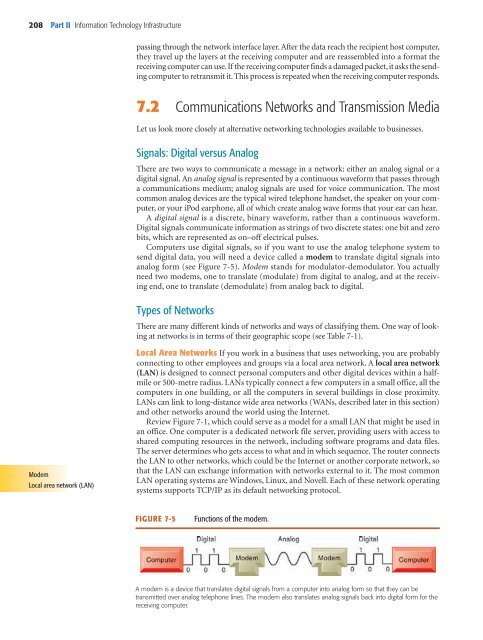Telecommunications, the Internet, and Wireless ... - Pearson Canada
Telecommunications, the Internet, and Wireless ... - Pearson Canada
Telecommunications, the Internet, and Wireless ... - Pearson Canada
You also want an ePaper? Increase the reach of your titles
YUMPU automatically turns print PDFs into web optimized ePapers that Google loves.
208 Part II Information Technology Infrastructure<br />
passing through <strong>the</strong> network interface layer. After <strong>the</strong> data reach <strong>the</strong> recipient host computer,<br />
<strong>the</strong>y travel up <strong>the</strong> layers at <strong>the</strong> receiving computer <strong>and</strong> are reassembled into a format <strong>the</strong><br />
receiving computer can use. If <strong>the</strong> receiving computer finds a damaged packet, it asks <strong>the</strong> sending<br />
computer to retransmit it. This process is repeated when <strong>the</strong> receiving computer responds.<br />
7.2 Communications Networks <strong>and</strong> Transmission Media<br />
Let us look more closely at alternative networking technologies available to businesses.<br />
Signals: Digital versus Analog<br />
There are two ways to communicate a message in a network: ei<strong>the</strong>r an analog signal or a<br />
digital signal. An analog signal is represented by a continuous waveform that passes through<br />
a communications medium; analog signals are used for voice communication. The most<br />
common analog devices are <strong>the</strong> typical wired telephone h<strong>and</strong>set, <strong>the</strong> speaker on your computer,<br />
or your iPod earphone, all of which create analog wave forms that your ear can hear.<br />
A digital signal is a discrete, binary waveform, ra<strong>the</strong>r than a continuous waveform.<br />
Digital signals communicate information as strings of two discrete states: one bit <strong>and</strong> zero<br />
bits, which are represented as on–off electrical pulses.<br />
Computers use digital signals, so if you want to use <strong>the</strong> analog telephone system to<br />
send digital data, you will need a device called a modem to translate digital signals into<br />
analog form (see Figure 7-5). Modem st<strong>and</strong>s for modulator-demodulator. You actually<br />
need two modems, one to translate (modulate) from digital to analog, <strong>and</strong> at <strong>the</strong> receiving<br />
end, one to translate (demodulate) from analog back to digital.<br />
Types of Networks<br />
There are many different kinds of networks <strong>and</strong> ways of classifying <strong>the</strong>m. One way of looking<br />
at networks is in terms of <strong>the</strong>ir geographic scope (see Table 7-1).<br />
Modem<br />
Local area network (LAN)<br />
Local Area Networks If you work in a business that uses networking, you are probably<br />
connecting to o<strong>the</strong>r employees <strong>and</strong> groups via a local area network. A local area network<br />
(LAN) is designed to connect personal computers <strong>and</strong> o<strong>the</strong>r digital devices within a halfmile<br />
or 500-metre radius. LANs typically connect a few computers in a small office, all <strong>the</strong><br />
computers in one building, or all <strong>the</strong> computers in several buildings in close proximity.<br />
LANs can link to long-distance wide area networks (WANs, described later in this section)<br />
<strong>and</strong> o<strong>the</strong>r networks around <strong>the</strong> world using <strong>the</strong> <strong>Internet</strong>.<br />
Review Figure 7-1, which could serve as a model for a small LAN that might be used in<br />
an office. One computer is a dedicated network file server, providing users with access to<br />
shared computing resources in <strong>the</strong> network, including software programs <strong>and</strong> data files.<br />
The server determines who gets access to what <strong>and</strong> in which sequence. The router connects<br />
<strong>the</strong> LAN to o<strong>the</strong>r networks, which could be <strong>the</strong> <strong>Internet</strong> or ano<strong>the</strong>r corporate network, so<br />
that <strong>the</strong> LAN can exchange information with networks external to it. The most common<br />
LAN operating systems are Windows, Linux, <strong>and</strong> Novell. Each of <strong>the</strong>se network operating<br />
systems supports TCP/ IP as its default networking protocol.<br />
FIGURE 7-5<br />
Functions of <strong>the</strong> modem.<br />
A modem is a device that translates digital signals from a computer into analog form so that <strong>the</strong>y can be<br />
transmitted over analog telephone lines. The modem also translates analog signals back into digital form for <strong>the</strong><br />
receiving computer.
















